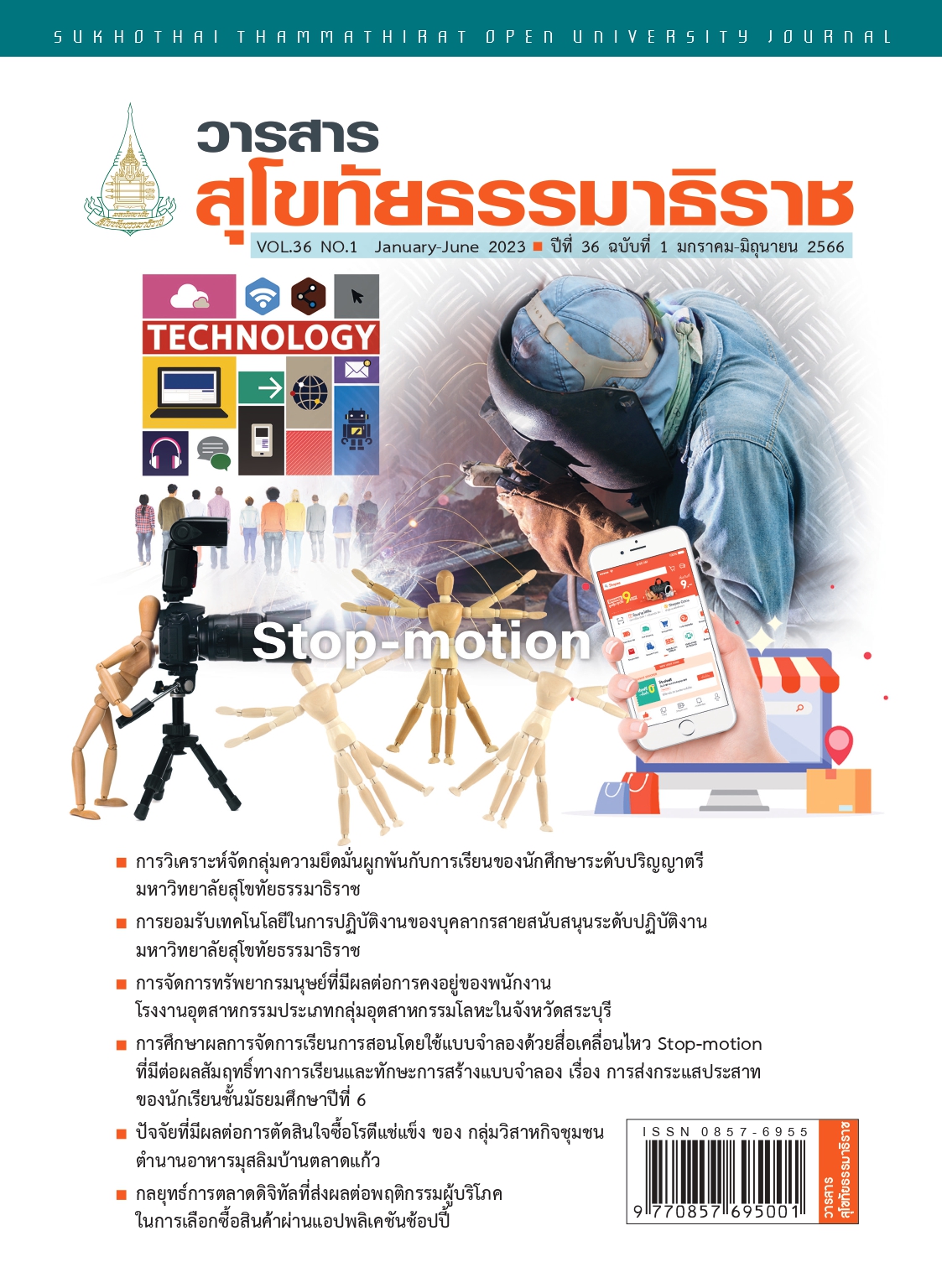การศึกษาผลการจัดการเรียนการสอนโดยใช้แบบจำลองด้วยสื่อเคลื่อนไหว Stop-motion ที่มีต่อผลสัมฤทธิ์ทางการเรียนและทักษะการสร้างแบบจำลองเรื่อง การส่งกระแสประสาท ของนักเรียนชั้นมัธยมศึกษาปีที่ 6
คำสำคัญ:
การจัดการเรียนการสอนโดยใช้แบบจำลอง, สื่อเคลื่อนไหว Stop-motion, ผลสัมฤทธิ์ทางการเรียนชีววิทยา, ทัักษะการสร้้างแบบจำลองบทคัดย่อ
งานวิจัยนี้มีวัตถุประสงค์เพื่อ 1) เปรียบเทียบผลสัมฤทธิ์ทางการเรียนก่อนเรียนและหลังเรียน เรื่อง การส่งกระแสประสาท ของนักเรียนระดับชั้นมัธยมศึกษาปีที่ 6 ที่ได้รับการจัดการเรียนการสอนโดยใช้แบบจำลองด้วยสื่อเคลื่อนไหว Stop-motion และ 2) หาความสัมพันธ์ระหว่างผลสัมฤทธิ์ทางการเรียนและทักษะการสร้างแบบจำลอง เรื่อง การส่งกระแสประสาทของนักเรียนชั้นมัธยมศึกษาปีที่ 6 ที่ได้รับการจัดการเรียนการสอนโดยใช้แบบจำลองด้วยสื่อเคลื่อนไหว Stop-motion กลุ่มตัวอย่างที่ใช้ในการวิจัยคือ นักเรียนชั้นมัธยมศึกษาปีที่ 6 โรงเรียนในจังหวัดพระนครศรีอยุธยา อำเภอพระนครศรีอยุธยา ที่เรียนอยู่ในแผนการเรียนวิทยาศาสตร์-คณิตศาสตร์ จำนวน 3 ห้องเรียน มีนักเรียนจำนวน 112 คน ซึ่งใช้วิธีการเลือกตัวอย่างแบบเจาะจงโดยเก็บและรวบรวมข้อมูลผ่านการใช้แบบทดสอบวัดผลสัมฤทธิ์ทางการเรียนทั้งก่อนและหลังเรียน และประเมินทักษะการสร้างแบบจำลองชีววิทยาจากการสร้างผลงานของนักเรียน
ผลการศึกษาพบว่า เมื่อนักเรียนได้รับการจัดการเรียนการสอนโดยใช้แบบจำลองด้วยสื่อเคลื่อนไหว Stop-motion เรื่อง การส่งกระแสประสาท ทำให้นักเรียนมีผลสัมฤทธิ์ทางการเรียนหลังเรียนสูงกว่าก่อนเรียนอย่างมีนัยสำคัญทางสถิติที่ระดับ .05 และเมื่อวิเคราะห์ความสัมพันธ์ระหว่างผลสัมฤทธิ์ทางการเรียนและทักษะการสร้างแบบจำลองของนักเรียน พบว่า ผลสัมฤทธิ์ทางการเรียนหลังได้รับการจัดการเรียนการสอนโดยใช้แบบจำลองด้วยสื่อเคลื่อนไหว Stop-motion เรื่อง การส่งกระแสประสาทไม่มีความสัมพันธ์กับทักษะการสร้างแบบจำลองในเชิงสถิติ
เอกสารอ้างอิง
Ackerman, E. (2001). Piaget’s Constructivism, Papert’s Constructionism: What’s the difference?.Retrieved from http://www.learning.media.mit.edu/content/publications/EA.Piaget%20_%20Papert.pdf
Ainsworth, S. (2006). DeFT: A conceptual framework for considering learning with multiplerepresentations. Learning and Instruction, 16(3), 183-198.
Ainsworth, S. (1999). The Functions of Multiple Representations. Computers & education, 33, 131-52.https://doi.org/10.1016/S0360-1315(99)00029-9
Anderson, L.W., Krathwohl, D. R., Airasian, P. W., Cruikshank, K. A., Mayer, R. E., Pintrich, P. R.,Raths, J.,and Wittrock, M. C. (Eds.) (2001). A Taxonomy for Learning, Teaching and Assessing: A Revision of Bloom’s Taxonomy of Educational Objectives. [Abridged Edition] New York : Longman.
Blair, J. M. (2014). Animated Autoethnographies: Stop Motion Animation as a Tool for Self-Inquiryand Personal Evaluation. Art Education, 67(2), 6-13. doi:10.1080/00043125.2014.11519259
Bryce, C. M., Baliga, V. B., De Nesnera, K. L., Fiack, D., Goetz, K., Tarjan, L. M., … Gilbert, G.S. (2016). Exploring Models in the Biology Classroom. The American Biology Teacher,78(1), 35-42. doi:10.1525/abt.2016.78.1.35
Chanatip Hotarapawanon, Sureeporn Sawangmek, and Wandee Wattanachaiyingcharoen. (2019).Developing of System Thinking for Mattayomsuksa 4 students in Nervous System and Sensory organs through Model-based Learning. Journal of Education Naresuan University, 21(2), 64-79. (in Thai)
Deaton, C. C. M., Deaton, B. E., Ivankovic, D.and Norris, F. A. (2013). Creating stop-motion videos with iPad to support students’ understandind of cell processes. Journal of Digital mLearning in Teacher Education, 30(2), 67-73. DOI: 10.1080/21532974. 2013.10784729
Ekici, E., & Fatma Ekici. (2014). Prospective Science Teachers’ Self-Assessments about the Use of Slowmation Approach in Teaching. European Journal of Social Science Education and Research, 1(1), 91-94. https://doi.org/10.26417/ejser.v1i1.p91-94.
Farrokhnia, M., Meulenbroeks, R. F. G., & van Joolingen, W. R. (2020). Student - Generated Stop-Motion Animation in Science Classes: a Systematic Literature Review. Journal of Science Education and Technology, 29(6), 797-812. doi:10.1007/s10956-020-09857-1
Fauzi, A., Rosyida, A. M., Rohma, M., and Khoiroh, D. (2021). The difficulty index of biology topicsin Indonesian Senior High School: Biology undergraduate students’ perspectives. JPBI (Jornal Pendidikan Biologi Indonesia), 7(2), 149-158. doi:https://doi.org/10.22219/jpbi.v7i2.16538
Karakoyun, F. and Yapici.İ. (2018). Use of Slowmation in Biology Teaching. International Education Studies, 11(10), 16-27. DOI: 10.5539/ies.v11n10p16
Nisit Chamnanpet, Sirinapa Kijkuakul and Maliwan Nakkuntod. (2562). Using action research to develop clay animation with model base teaching to encourage concept developing in the topic of digestive system, Journal of Education Naresuan University, 21(4), 183-197. (in Thai)
Nungruthai Kiatphimon. (2016). Effects of using Representation construction approach on modeling ability and learning achievement in biology of upper secondary school students. (Master’s Thesis). Chulalongkorn University, Faculty of Education, Program in Science Education. (in Thai)
Off ice of the Basic Education Commission. (2017). Indicators and core learning content of Department of Science (revised edition B.E. 2551) follow by Basic Education Core Curriculum B.E. 2551 (A.D. 2008). Bangkok : Agricultural cooperative printing demonstrations of Thai co., Ltd.
Piyanat Nantakarn (2008). Effect of learning by Design on biology concepts and ability in making model of upper secondary school students. (Master’s Thesis). Chulalongkorn University, Faculty of Education, Program in Science Education. (in Thai)
Schönborn, K. J., & Anderson, T. R. (2008). A Model of Factors Determining Students’ Ability to Interpret External Representations in Biochemistry. International Journal of Science Education, 31(2), 193-232. doi:10.1080/09500690701670535
Schwarz, C. V., Reiser, B. J., Davis, E. A., Kenyon, L., Achér, A., Fortus, D., Krajcik, J. (2009). Developing a learning progression for scientific modeling: Making scientific modeling accessible and meaningful for learners. Journal of Research in Science Teaching, 46(6), 632-654. doi:10.1002/tea.20311
Schweingruber, H., Keller, T., & Quinn, H. (Eds.). (2012). A Framework for K-12 Science Education: Practices, Crosscutting Concepts, and Core Ideas. National Academies Press.
Tsui, C.-Y., & Treagust, D. F. (2013). Introduction to Multiple Representations:Their Importance in Biology and Biological Education. In Multiple Representations in Biological Education (pp. 3-17). New York, NY: Springer.
Wilasinee Jansrimai, Porntip Supatchaiyawong, and Supaporn Dawan. (2020). Inquiry-based learning for develop concepts at the microscopic levels of galvanic cells through the creation of stop motion work pieces. Thaksin University Library Journal. 9(1). 58-78. (in Thai)
Wilkerson, M. H., Shareff, R., Laina, V., & Gravel, B. (2017). Epistemic gameplay and discovery in computational model-based inquiry activities. Instructional Science, 46(1), 35–60. doi:10.1007/s11251-017-9430-4.
Wipanee Chirathonphakdi. (2011). A study on biology learning achievement and analytical thinking through problem-based learning and the six thinking hats technique of matthayomsuksa 6 students. (Master’s Thesis). Srinakharinwirot University, Faculty of Sciences, Program in Science Education. (in Thai)
Xiang, L., & Passmore, C. (2014). A Framework for Model-Based Inquiry Through Agent-Based Programming. Journal of Science Education and Technology, 24(2-3), 311-329. doi:10.1007/s10956-014-9534-4
ดาวน์โหลด
เผยแพร่แล้ว
เวอร์ชัน
- 2024-02-01 (2)
- 2023-09-05 (1)
รูปแบบการอ้างอิง
ฉบับ
ประเภทบทความ
สัญญาอนุญาต
ลิขสิทธิ์ (c) 2023 มหาวิทยาลัยสุโขทัยธรรมาธิราช

อนุญาตภายใต้เงื่อนไข Creative Commons Attribution-NonCommercial-NoDerivatives 4.0 International License.
บทความที่ได้รับการตีพิมพ์เป็นลิขสิทธิ์ของวารสารมหาวิทยาลัยสุโขทัยธรรมาธิราช
ข้อความที่ปรากฏในบทความแต่ละเรื่องในวารสารวิชาการเล่มนี้เป็นความคิดเห็นส่วนตัวของผู้เขียนแต่ละท่านไม่เกี่ยวข้องกับมหาวิทยาลัยสุโขทัยธรรมาธิราช และคณาจารย์ท่านอื่นๆในมหาวิทยาลัยฯ แต่อย่างใด ความรับผิดชอบองค์ประกอบทั้งหมดของบทความแต่ละเรื่องเป็นของผู้เขียนแต่ละท่าน หากมีความผิดพลาดใดๆ ผู้เขียนแต่ละท่านจะรับผิดชอบบทความของตนเองแต่ผู้เดียว
ห้ามนำข้อความทั้งหมด หรือบางส่วนไปพิมพ์ซ้ำ เว้นแต่จะได้รับอนุญาตจากกองบรรณาธิการวารสาร



